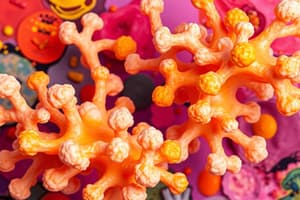Podcast
Questions and Answers
What is the primary function of polysaccharides?
What is the primary function of polysaccharides?
- Nerve signal transmission
- Food and energy storage (correct)
- Hormone production
- Electrical insulation
Which type of amylase is found in saliva?
Which type of amylase is found in saliva?
- Gamma-amylase
- Delta-amylase
- Beta-amylase
- Alpha-amylase (correct)
What type of linkage is not found in amylose?
What type of linkage is not found in amylose?
- β-1,4 linkage
- α-1,4 linkage
- α-1,2 linkage
- α-1,6 linkage (correct)
How does starch serve as a convenient storage material?
How does starch serve as a convenient storage material?
Which of the following statements about amylopectin is true?
Which of the following statements about amylopectin is true?
Which characteristic is true for pure starch?
Which characteristic is true for pure starch?
What are the two primary components of starch?
What are the two primary components of starch?
Which of the following describes a property of polysaccharides?
Which of the following describes a property of polysaccharides?
Which glycosidic bonds are present in glycogen?
Which glycosidic bonds are present in glycogen?
What happens to dietary fiber's water holding capacity?
What happens to dietary fiber's water holding capacity?
What color does iodine turn when it reacts with inulin?
What color does iodine turn when it reacts with inulin?
Which characteristic defines mucopolysaccharidoses?
Which characteristic defines mucopolysaccharidoses?
What is a significant source of inulin?
What is a significant source of inulin?
What best describes the structure of proteoglycans?
What best describes the structure of proteoglycans?
How does dietary fiber affect cholesterol absorption?
How does dietary fiber affect cholesterol absorption?
What type of linkage is found in inulin?
What type of linkage is found in inulin?
Flashcards
Polysaccharides
Polysaccharides
Large molecules made up of many sugar units linked together.
Starch
Starch
A polysaccharide made of glucose units, used for energy storage, mainly in plants.
Amylose
Amylose
A linear chain of glucose monomers in starch, connected by α(1→4) glycosidic bonds.
Amylopectin
Amylopectin
Signup and view all the flashcards
α-amylase
α-amylase
Signup and view all the flashcards
β-amylase
β-amylase
Signup and view all the flashcards
Glycosidic bond
Glycosidic bond
Signup and view all the flashcards
Energy storage
Energy storage
Signup and view all the flashcards
Glycogen Structure
Glycogen Structure
Signup and view all the flashcards
Inulin: A Fructosan
Inulin: A Fructosan
Signup and view all the flashcards
Dietary Fiber Function
Dietary Fiber Function
Signup and view all the flashcards
Glycosaminoglycans (GAGs) Structure
Glycosaminoglycans (GAGs) Structure
Signup and view all the flashcards
Mucopolysaccharidoses (MPS)
Mucopolysaccharidoses (MPS)
Signup and view all the flashcards
Proteoglycans
Proteoglycans
Signup and view all the flashcards
What are the monomers of Inulin?
What are the monomers of Inulin?
Signup and view all the flashcards
What is the role of lysosomal enzymes in MPS disorders?
What is the role of lysosomal enzymes in MPS disorders?
Signup and view all the flashcards
Study Notes
Polysaccharides
- Polysaccharides are high molecular weight carbohydrates
- They are insoluble non-sugars
- On hydrolysis, they yield monosaccharides or related products
- They're polymeric anhydrides of simple sugars
- D-glucose is a key component
Polysaccharide Types
- Homopolysaccharides: Yield a single monosaccharide on hydrolysis
- Storage: Starch, glycogen, inulin
- Structural: Cellulose, pectin, chitin
- Heteropolysaccharides: Yield a mixture of monosaccharides on hydrolysis
- Glycosaminoglycans (mucopolysaccharides): Hyaluronic acid, chondroitin sulfates (A and C), dermatan sulfate, and keratosulfate, heparin
- Other constituents: D- and L-galactose, D-mannose, D-xylose, L-arabinose, D-glucuronic acid, D-galacturonic acid, D-mannuronic acids, D-glucoseamine, D-galactoseamine, aminouronic acids
Polysaccharide Functions
- Energy storage: Starch, glycogen, inulin
- Structural components: Cellulose, pectin, chitin, glycosaminoglycans
- Other functions: Aids in digestion, make up cell and tissue structures, and are a source of carbon for synthesis of other compounds
Starch
- Polymer of α-glucose
- Stored as starch grains in chloroplasts and storage organs (e.g., potatoes, seeds)
- Consists of two types:
- Amylose (linear, helical)
- Amylopectin (branched)
- More than half of human carbohydrate intake is starch
Glycogen
- D-Glucose linked by α-1,4 and α-1,6 glycosidic bonds
- Branches formed after 8-10 residues
- A major energy reserve in animals
- Stored in the liver and muscles (up to 7% of wet weight)
- Particles much smaller than starch grains
Inulin
- Polymer of D-fructose, β-(1,2) linked fructofuranoses
- Linear, no branching
- Lower molecular weight than starch
- Colors yellow with iodine
- Hydrolysis yields fructose
- Stored in tubers (dahlia, artichoke) and roots (dandelion)
- Used as a dietary fiber, appetite suppressant, and in treating kidney disease
Cellulose
- Linear polymer of β-D-glucose linked by β(1−4) glycosidic bonds
- Most abundant polysaccharide
- Present in all land plants, but not in animals
- Not digestible by humans
- Forms plant cell walls (40-70%)
Pectin
- Polysaccharide of α-D-galacturonic acid
- Found as intercellular substances in young plants and fruits
- Forms jellies with sugars
- Used as gelling agent in jams and jellies
Chitin
- Polymer of N-acetyl-D-glucosamine, β(1→4) glycosidic bonds.
- Important structural component in fungi, crab shells, and insect exoskeletons.
- Impregnated with calcium carbonate to enhance strength
Heteropolysaccharides (Glycosaminoglycans)
- Polymers assembled from disaccharides
- Mucopolysaccharide disorders are caused by defective lysosomal enzymes
- Examples: hyaluronic acid, chondroitin sulfates (A and C), dermatan sulfate and keratosulfate, and heparin
Hyaluronic Acid
- Straight-chain polymer of D-glucuronic acid and N-acetyl-D-glucosamine (NAG)
- Abundant in connective tissues (synovial fluid, vitreous humor of eye)
- High viscosity, acts as a lubricant and helps cement tissues
- Involved in fertilization
Chondroitin
- Related to hyaluronic acid
- Polymer of D-glucuronic and N-acetyl-galactosamine
- Component of cartilage, tendons and cell coats
Chondroitin Sulfates (A and C)
- Modifications of chondroitin with sulfate
- Widely distributed in cartilage, tendons, and bones
- Contribute to structural support
Dermatan Sulfate
- Structurally similar to chondroitin sulfate A
- Contains L-iduronic acid instead of D-glucuronic acid
- Component of connective tissues
Heparin
- Sulfated heteropolysaccharide
- Anticoagulant, inhibits blood clotting
- Found in liver, lungs, and mast cells
Proteoglycans
- Core proteins covalently attached to glycosaminoglycans
- Important components of connective tissues
Uses of Polysaccharides
- Water treatment: remove metal ions, filtration
- Pulp and paper: surface treatment
- Biomedical: bandages, sponges, artificial materials, controlling drug release
- Cosmetics: make-up powder nail polish, moisturizers
- Biotechnology: enzyme/cell immobilization, protein separation
- Agriculture: seed/leaf coating, fertilizer
Studying That Suits You
Use AI to generate personalized quizzes and flashcards to suit your learning preferences.




